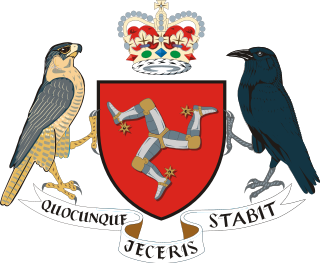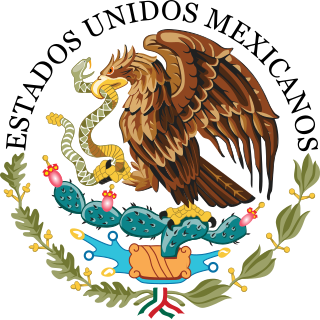
The government of the Isle of Man is a parliamentary representative democracy. The Monarch of the United Kingdom is also the head of state of the Isle of Man, and generally referred to as "The King, Lord of Mann". Legislation of the Isle of Man defines "the Crown in right of the Isle of Man" as separate from the "Crown in right of the United Kingdom". His representative on the island is the Lieutenant Governor of the Isle of Man, but his role is mostly ceremonial, though he does have the power to grant Royal Assent.

Politics of Samoa takes place in a framework of a parliamentary representative democratic state whereby the Prime Minister of Samoa is the head of government. Existing alongside the country's Western-styled political system is the fa'amatai chiefly system of socio-political governance and organisation, central to understanding Samoa's political system.

The federal government of the United States is the national government of the United States, a federal republic located primarily in North America, composed of 50 states, five major self-governing territories, several island possessions, and the federal district/national capital of Washington, D.C., where most of the federal government is based.
Faʻa Sāmoa, the 'Samoan Way', is the traditional/customary way of life in Samoan culture.

The American Samoa Fono is the territorial legislature of American Samoa. Like most states and territorial legislatures of the United States, it is a bicameral legislature with a House of Representatives and a Senate. The legislature is located in Fagatogo along Pago Pago harbor.

The American Samoa House of Representatives is the lower house of the American Samoa Fono. The House consists of 21 members serving two-year terms, with 20 popularly elected representatives, and one delegate from Swains Island elected in a public meeting.

The American Samoa Senate is the upper house of the American Samoa Fono. The Senate, like the lower House of Representatives, is a nonpartisan body. It is composed of 18 senators, serving a four-year term.

American Samoa is administratively divided into three districts and two unorganized atolls. The districts are subdivided into 15 counties, which are composed of 76 villages.

The High Court of American Samoa is a Samoan court and the highest court below the United States Supreme Court in American Samoa. The Court is located in the capital of Fagatogo. It consists of one chief justice and one associate justice, appointed by the United States Secretary of the Interior, holding office during "good behavior" and removable for cause. As American Samoa has no local federal district court or territorial court, the High Court has also been granted the powers of a federal district court in certain matters while other federal matters are handled by the United States District Court for the District of Columbia and the United States District Court for the District of Hawaii.

The following outline is provided as an overview of and topical guide to American Samoa:
The government of American Samoa is defined under the Constitution of American Samoa.

Faʻamatai is the indigenous political ('chiefly') system of Samoa, central to the organization of Samoan society. It is the traditional indigenous form of governance in both Samoas, comprising American Samoa and the Independent State of Samoa. The term comprises the prefix faʻa and the word matai.

American Samoa is an unincorporated territory of the United States located in the Polynesia region of the South Pacific Ocean. Centered on 14.3°S 170.7°W, it is southeast of the island country of Samoa, east of the International Date Line and the Wallis and Futuna Islands, west of the Cook Islands, north of Tonga, and some 310 miles (500 km) south of Tokelau. American Samoa is the southernmost territory of the United States, situated 2,200 miles (3,500 km) southwest of the U.S. state of Hawaii, and one of two U.S. territories south of the Equator, along with the uninhabited Jarvis Island.

The Federal Government of Mexico is the national government of the United Mexican States, the central government established by its constitution to share sovereignty over the republic with the governments of the 31 individual Mexican states, and to represent such governments before international bodies such as the United Nations. The Mexican federal government has three branches: executive, legislative, and judicial and functions per the Constitution of the United Mexican States, as enacted in 1917, and as amended. The executive power is exercised by the executive branch, which is headed by the president and her Cabinet, which, together, are independent of the legislature. Legislative power is vested upon the Congress of the Union, a bicameral legislature comprising the Senate and the Chamber of Deputies. Judicial power is exercised by the judiciary, consisting of the Supreme Court of Justice of the Nation, the Council of the Federal Judiciary, and the collegiate, unitary, and district courts.
Samoa, officially the Independent State of Samoa, has a population of approximately 188,000 people. Samoa gained independence from New Zealand in 1962 and has a Westminster model of Parliamentary democracy which incorporates aspects of traditional practices. In 2016, Samoa ratified the Convention on the Rights of Persons with Disabilities CRPD and the three optional protocols to the CRC
The Judiciary of American Samoa is defined under the Constitution of American Samoa and the American Samoa Code. It consists of the High Court of American Samoa, a District Court, and village courts, all under the administration and supervision of the Chief Justice. The High Court and District Court are both located in Fagatogo. The Chief Justice and the Associate Justice of the High Court are appointed by the United States Secretary of the Interior. Associate judges of the High Court, who may also serve in the village courts, and judges of the District Court are appointed by the Governor of American Samoa upon the recommendation of the Chief Justice and confirmed by the Senate.
The Judiciary of California or the Judicial Branch of California is defined under the California Constitution as holding the judicial power of the state of California which is vested in the Supreme Court, the Courts of Appeal and the Superior Courts. The judiciary has a hierarchical structure with the California Supreme Court at the top, California Courts of Appeal as the primary appellate courts, and the California Superior Courts as the primary trial courts.

Montana District Courts are the state trial courts of general jurisdiction in the U.S. state of Montana. Montana District Courts have original jurisdiction over most civil cases, civil actions involving monetary claims against the state, criminal felony cases, naturalization proceedings, probate cases, and most writs. They may also hear certain special actions and proceedings, and oversee a narrowly-defined class of ballot issues. Montana District Courts also have limited appellate jurisdiction regarding cases that arise in Justice Courts, City Courts, and Municipal Courts as well as Judicial review of decisions by state administrative law tribunals that fall under the Montana Administrative Procedures Act.
The Land and Titles Bill is one of three bills passed by the Legislative Assembly of Samoa to reform the legal framework around the Land and Titles Court of Samoa and Samoan customary law. The bills are viewed by some as undermining human rights and the rule of law, and are the subject of significant controversy in Samoa.

American Samoa consists of a group of two coral atolls and five volcanic islands in the South Pacific Ocean of Oceania. The first permanent European settlement was founded in 1830 by British missionaries, who were followed by explorers from the United States, in 1839, and German traders in 1845. Based upon the Tripartite Convention of 1899, the United States, Great Britain, and Germany agreed to partition the islands into German Samoa and American Samoa. Though the territory was ceded to the United States in a series of transactions in 1900, 1904, and 1925, Congress did not formally confirm its acquisition until 1929. American Samoans are non-citizen nationals of the United States. Non-citizen nationals do not have full protection of their rights, though they may reside in the United States and gain entry without a visa. Territorial citizens do not have the ability for full participation in national politics and American Samoans cannot serve as officers in the US military or in many federal jobs, are unable to bear arms, vote in local elections, or hold public office or civil-service positions even when residing in a US state. Nationality is the legal means in which inhabitants acquire formal membership in a nation without regard to its governance type. Citizenship is the relationship between the government and the governed, the rights and obligations that each owes the other, once one has become a member of a nation.











